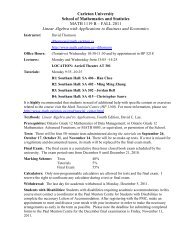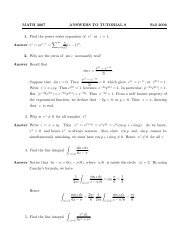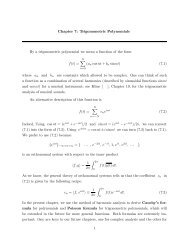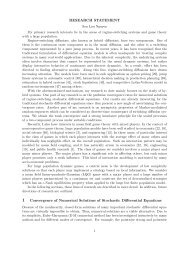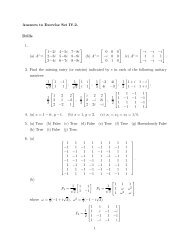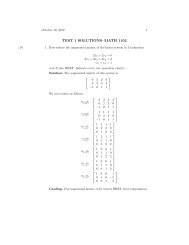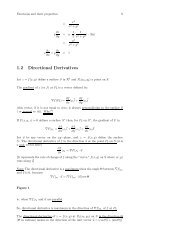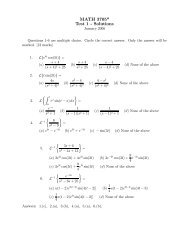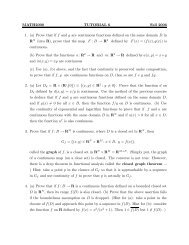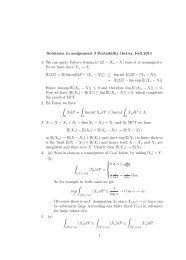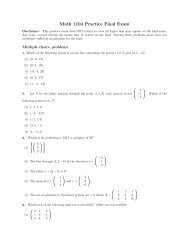CHAPTER II DIMENSION In the present chapter we investigate ...
CHAPTER II DIMENSION In the present chapter we investigate ...
CHAPTER II DIMENSION In the present chapter we investigate ...
Create successful ePaper yourself
Turn your PDF publications into a flip-book with our unique Google optimized e-Paper software.
§2. Dimension<br />
2.1. The main purpose of <strong>the</strong> <strong>present</strong> subsection is to establish <strong>the</strong> <strong>the</strong>orem stated<br />
below. The key role played by this <strong>the</strong>orem in linear algebra is to justify <strong>the</strong> definition of<br />
<strong>the</strong> dimension of a vector space.<br />
Theorem 2.1.1. Any two bases of a vector space have <strong>the</strong> same number of vectors.<br />
Let V be a finite dimensional vector space. Take any basis in V ; (<strong>we</strong> can do this because<br />
V has a basis according to Corollary 1.4.3 in <strong>the</strong> previous section. This <strong>the</strong>orem tells us<br />
that <strong>the</strong> number of vectors in it does not depend on which basis <strong>we</strong> pick. So <strong>we</strong> can define<br />
<strong>the</strong> dimension of V to be <strong>the</strong> number of vectors in any basis of V , denoted by dim V .<br />
We provide two proofs of this <strong>the</strong>orem. The first proof given here is based on <strong>the</strong><br />
material about leading vectors described in <strong>the</strong> last section. Let us take two bases of V ,<br />
say E consisting of vectors e1, e2, . . . , em and F consisting of f1, f2, . . . , fn. Here of<br />
course m and n are number of vectors in <strong>the</strong> bases E and F respectively. We need to prove<br />
m = n. Without loss of generality, let us assume n ≤ m. We use F as a coordinate<br />
system to convert vectors in E into column vectors in F n . Let<br />
Ck = [ek]F (1 ≤ k ≤ m) and C = [C1 C2 · · · Cm].<br />
Notice that C is an n × m matrix, with n ≤ m. Since <strong>the</strong> vectors e1, e2, . . . , em are<br />
linearly independent, all of <strong>the</strong>m are leading vectors. This fact carries over to <strong>the</strong> column<br />
vectors of C: all of C1, C2, . . . , Cm are leading vectors. Hence <strong>the</strong> reduced row echelon<br />
form of C must be ⎡<br />
1 0<br />
⎤<br />
0<br />
⎢ 0<br />
⎢<br />
⎣<br />
1<br />
. ..<br />
0 ⎥<br />
⎦<br />
0 0 1<br />
which is necessarily a square matrix. So C is a square matrix as <strong>we</strong>ll. Thus m = n.<br />
Example 2.1.2. Now <strong>we</strong> determine <strong>the</strong> dimensions of familiar spaces. First, <strong>the</strong><br />
dimension of F n is n, since <strong>the</strong> standard basis given as follows has exactly n vectors:<br />
e1 = (1, 0, . . . , 0, 0), e2 = (0, 1, . . . , 0, 0), . . . , en = (0, 0, . . . , 0, 1).<br />
The linear space Mmn(F) of all m × n matrices over F can be identified with F mn (as<br />
long as <strong>the</strong> linear structure is concerned and hence its dimension is mn. Next, <strong>the</strong> space<br />
Pn of all polynomials of degree not exceeding n is of dimension n + 1, since its standard<br />
basis consisting of<br />
1, x, x 2 , . . . , x n−1 , x n<br />
14



